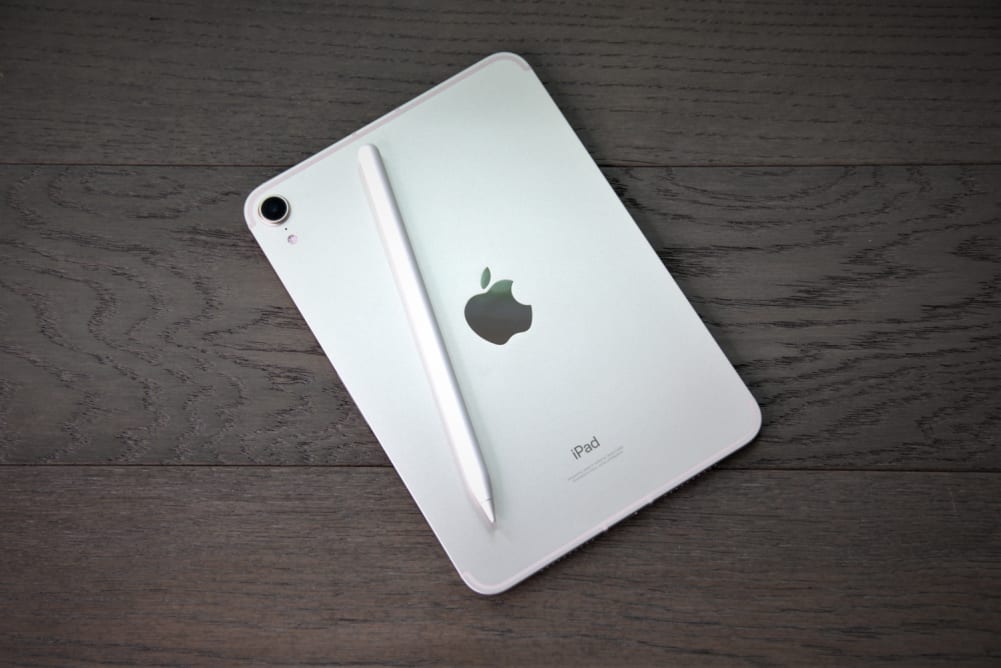Pros
-
Light, portable, and easy to handle
-
Perfect for use with Apple Pencil
-
Superb performance
Cons
-
Unimpressive display
-
Not great for multitasking
-
No Face ID
About the iPad Mini (6th-gen)
Here are the specs of the tablet we tested:
- Chipset: Apple A15 Bionic
- Display: 8.3-inch Liquid Retina LED Touchscreen
- RAM: 4GB
- Storage: 64GB, 256GB
- Rear-facing camera: 12MP wide angle
- Front-facing camera: 12MP ultra wide angle
- Wired connectivity: USB-C
- Wireless connectivity: Bluetooth 5, Wi-Fi 6, optional Cellular 5G/4G LTE
- Colors: Space Gray, Starlight, Pink, Purple
What we like
You can grab it and go
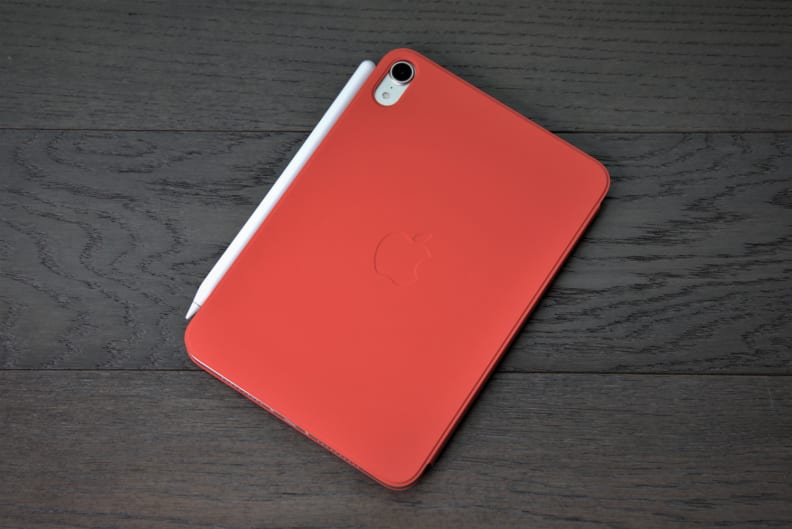
If you need a small and super portable tablet, the iPad Mini 6th-gen should be great for you.
The iPad Mini is small. Held in portrait mode, it’s less than 8 inches tall and 5.5 inches wide. That’s almost identical to a classic Moleskine notebook. Its weight is similar, too, at two-thirds of a pound.
The new, 6th-gen iPad Mini is slightly smaller overall than its predecessors, but the difference is a few tenths of an inch. Apple’s new design increases the screen size from 7.9 to 8.3 inches while retaining a familiar footprint.
Still, the iPad Mini is a wonderfully portable device and it should fit into any bag that can hold a typical paperback book with room to spare. It’s also lighter than most books, so carrying it around is no big deal at all.
This is great when traveling, but also comfortable for home use. The iPad Mini is easy to pick up one-handed and hold in most positions you’d normally hold an iPhone Pro Max. If you have large hands you should be able to grip the iPad Mini’s width with an open palm, making the tablet easy to hold while reclining on a couch or in bed.
Pairs nicely with the Apple Pencil
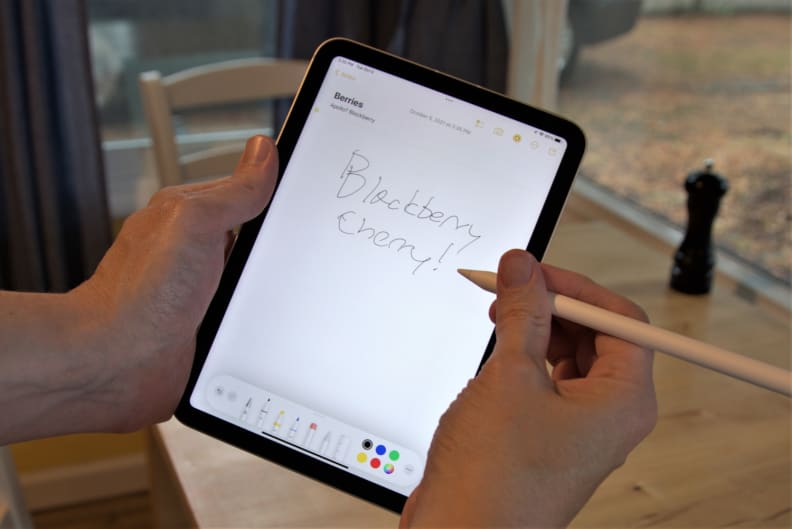
If you decide to pick up the iPad Mini 6th-gen, you should seriously consider getting the Apple Pencil 2 to go with it.
The new iPad Mini supports Apple’s 2nd-generation Pencil, an optional accessory sold for $129. That’s pricey, but it massively expands how you can use the Mini day-to-day.
The iPad Mini’s size makes it easy to hold, and being easy to hold makes the Mini ideal for use with the Apple Pencil. The comparison to a classic Moleskine remains relevant. You can quickly jot down a handwritten note or comfortably write several paragraphs. This is true of the other iPad models, as well, but the Mini’s size and lack of an available keyboard cover (from Apple, at least) mean you’re more likely to use the Pencil.
In fact, the Mini is easier to use than most old-school notebooks. Paper has this awful tendency to bend and flex as you write, which can make using a notebook tricky when a flat surface isn’t available. The Mini is always rigid, so it’s easy to jot down a legible note while holding it with your other hand.
Unfortunately, the first-gen Pencil is not compatible. This could frustrate current iPad Mini owners, as the prior model only supports the original Pencil. The 2nd-gen model can charge wirelessly and arguably feels more premium in hand, but the two Pencil models deliver identical performance.
Mighty performance
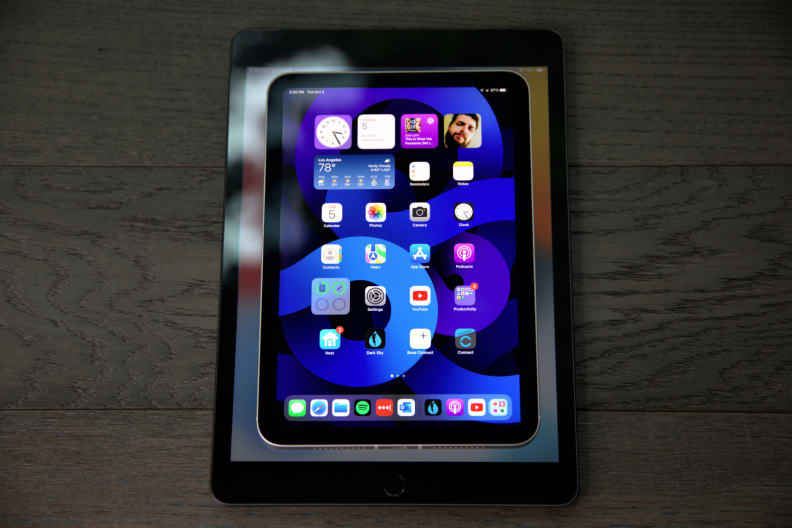
The Apple iPad Mini 6th-gen is much smaller in size compared to the standard iPad.
Apple’s A15 Bionic powers the new iPad Mini, as well as the new iPhone 13 and iPhone 13 Pro Max. It’s a nice on-paper upgrade from the prior Mini, which had Apple’s A12 Bionic first introduced in 2018. When we tested and compared the raw, multi-core processing power of each in Geekbench 5, the 5th-gen iPad Mini scored 2678, while the 6th-gen mini scored 4675. (Higher is better.) The new Mini also has 4GB of RAM, up from 3GB in the prior model, which also helped boost its score.
This significant leap in performance isn’t immediately noticeable, though only because Apple’s iPad line has offered stellar performance for years. The iPad Mini is no exception. It can breeze through any task, from photo editing to heavy multi-tab web browsing and 3D gaming. Odds are good this Mini will be smoother and more responsive than the device you’re using to read this review—even if you’re on a high-end Windows PC.
This may be difficult to believe, but consider this: in Geekbench 5, the Mini’s single-core score is competitive with any modern Intel Core i5 or AMD Ryzen 5 desktop CPU. The Mini falls behind desktop chips in the multi-core test but remains competitive with some of Intel’s mobile processors, such as those found in the Dell XPS 13 and older MacBook Pro 13. Throw in the low overhead of iPadOS and you have a recipe for blistering speed in most tasks.
The speed doesn’t sacrifice battery life, either. I used the iPad Mini heavily over a week but never saw battery life dip below 45% (I charged the device every night). The pace of battery consumption in games suggests a demanding 3D title can drain the battery after a few hours of use. That might seem dire, but it’s no worse than a Nintendo Switch or 3DS.
Outstanding iPad performance is not new. Still, it’s worth taking a step back to marvel at what the Mini can accomplish. The Mini’s performance is on par with a price-competitive PC laptop, like an Acer Swift 3, yet it’s the size of a notebook and can last all day on a charge. That’s remarkable.
5G and USB-C
The iPad Mini has a USB-C port, as do Apple’s iPad Pro models, instead of the Lightning port found on the iPhone and base iPad. It’s a small but positive change that makes the iPad Mini broadly compatible with the USB-C cables you’ll use to charge other devices in your life.
It also supports 5G if you opt for the cellular model. The rollout of 5G remains slow in the United States, but it’s the future of cellular connectivity, so it’s good to find it on the iPad Mini. This sets the iPad Mini apart from the more affordable iPad, which lacks 5G on cellular models.
What we don’t like
Lackluster display
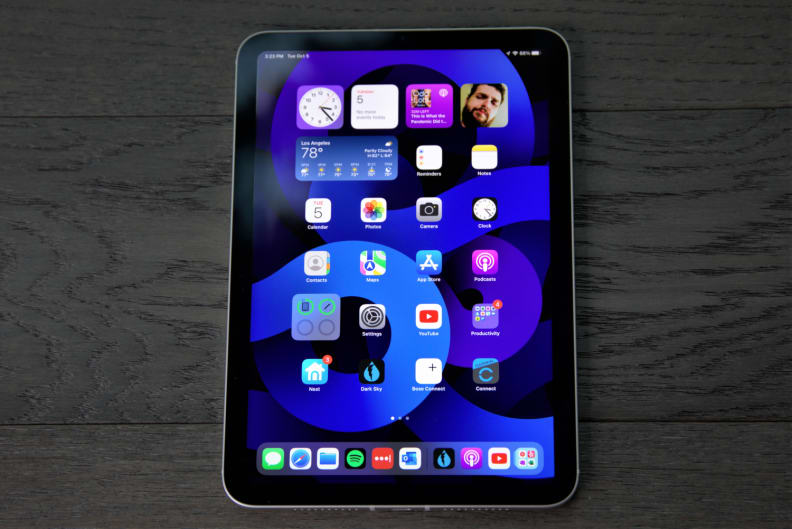
The iPad Mini 6th-gen's display is fine for everyday web browsing, but it's not particularly impressive.
There’s a lot to love about the new iPad Mini’s designs and internals, but your first impression may be underwhelming. That has everything to do with the display.
The new iPad Mini has an 8.3-inch Liquid Retina display with a resolution of 2266 x 1488. That works out to 326 pixels per inch. It’s plenty sharp and also bright enough for use anywhere but a sunny park (I measured a maximum brightness of 426 nits), but it lacks cutting-edge features like an OLED display panel, a Mini-LED backlight, HDR, or an enhanced refresh rate. Features like these are common on not just competing tablets and phones but Apple’s own devices such as the iPad Pro and the iPhone 13.
There’s also a minor problem: jelly scroll. You might (or might not) notice the display looks slightly skewed as you scroll through a web page or photos. I’m certain most iPad Mini owners will never even notice this issue, but this oddity is not found on the prior Mini or other iPads.
Size is an issue, too. The screen isn’t ideal for watching YouTube videos or Netflix while you’re not holding the tablet. I often watch YouTube while cooking dinner or exercising and missed the larger size of my 10-inch iPad Pro and the base iPad model. The smaller iPad Mini can obscure details in videos, making it hard to see small objects and appreciate fine elements like text or graphs. This can also be true in games that have small interface elements or a lot of detail in distant scenery.
iPadOS looks awkward on the iPad Mini
The size of the iPad Mini is an awkward fit between the iPhone and other iPads. The Mini is much larger than even the iPhone 13 Pro Max but much smaller than the base iPad or 11-inch iPad Pro. Its unique size is a challenge iPadOS fails to overcome.
It starts on the home screen. Compared to my 10-inch iPad Pro (2nd-gen), the iPad Mini displays significantly fewer columns in a row (six versus four) and icons appear far smaller. Text is smaller, too, and in some cases smaller than on my iPhone 12 Mini.
This carries over to Safari. Text is always smaller than on the iPad Pro, of course, and often smaller than the iPhone 12 Mini. This happens because iPadOS displays content differently from iOS on an iPhone. I see less content on my iPhone, but the text is larger and easier to read. The iPad Mini displays more content, but small fonts can be difficult to discern without zooming in.
iPadOS is packed with font size, icon size, and accessibility features that combat the usability issues caused by the small display, but Apple should give the out-of-box experience second thought. It feels off-putting and if you have less than perfect eyesight you could have trouble reading what's on the screen.
The iPad Mini is also a poor choice for multitasking. You can use Split View and Slide Over to view two apps at once but the small screen immediately feels too crowded and apps can’t display much content at once. If you like using apps side-by-side you should buy a larger iPad.
The cameras could use an upgrade
The iPad Mini has a 12MP rear-facing camera—a decent increase over the 8MP rear-facing camera on the standard iPad—and a 12MP ultrawide front-facing camera that appears to be identical to the standard iPad. Both cameras are an upgrade over the prior iPad Mini, which had an 8MP rear-facing camera and a 7MP front-facing camera.
The new Mini’s cameras take usable but unimpressive photos. They struggle most with low light, as the iPad Mini lacks the Night Mode feature found on current iPad Pros and iPhones.
Both cameras also lack Portrait Mode, which surprised me. Even the budget-friendly iPhone SE supports Portrait Mode and can snap some nice selfies with the mode on. You’ll want to keep your smartphone close at hand even when snapping a quick shot to post on Instagram.
Where is Face ID?
Apple decided not to add Face ID, which can unlock your device using facial recognition, to the iPad Mini. It instead has fingerprint-based Touch ID login built into the power button.
This is the worst biometric login system I’ve encountered on an Apple device. I found the button’s location was difficult to access when picking up the iPad Mini. My hand naturally grips the center of the display tablet, leaving the power button too far away to access without shifting my grip. The Mini also wakes automatically when I tap the display. These quirks made Touch ID feel inconvenient, so I often entered my passcode instead.
Face ID is a wonderful technology that makes a device feel quicker, more approachable, and more premium. Its absence is a mark against this generation of iPad Mini that will haunt it for years to come.
Should you buy it?
Maybe, if you’re ride-or-die for small tablets
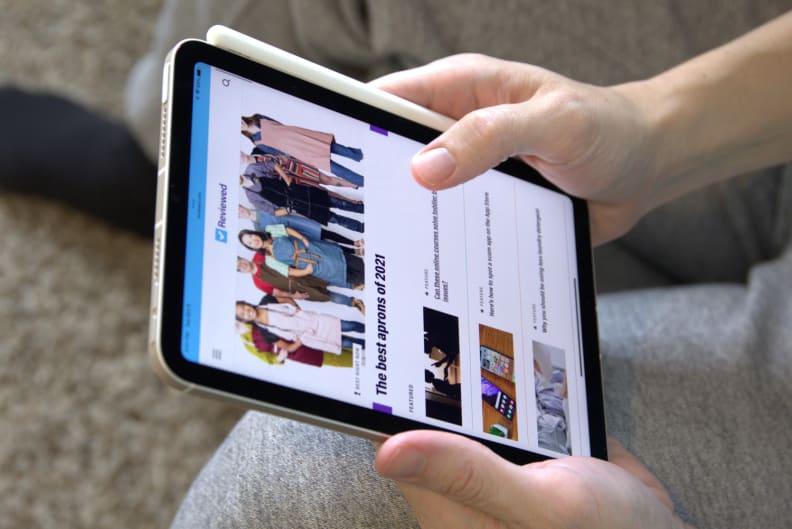
The Apple iPad Mini 6th-gen acts a little quirky with iPadOS.
The most important thing you should know about the iPad Mini is this: it’s an iPad, not an iPad Pro. The iPad Mini looks like an iPad Pro but falls behind in display quality, camera performance, and the lack of Face ID login.
That’s not to say the iPad Mini lacks merit. It excels in key areas including performance, battery life, and day-to-day usability. Still, it’s clear the iPad Mini’s defining feature is its size. You should buy the iPad Mini because you want a small tablet—not because you perceive it as an upgrade over the base iPad or as a cheaper iPad Pro.
This makes the new iPad Mini’s price surprising. The Mini starts at $499 with only 64GB of storage. Upgrading to 256GB of storage, which is a better bet, bumps the price to an alarming $649. Tack on cellular data and you’re looking at $799. Adding an Apple Pencil and a Smart Folio puts the all-in, as-tested price at $987.
That’s a lot of money. The iPad Pro is also expensive, but it’s a powerhouse crammed with high-end features and performance equal to a MacBook Pro 13. The iPad Pro is a tablet that can replace a Mac or PC laptop. The iPad Mini can’t.
If you want a small tablet, and you’re willing to spend at least $499, go for it. The iPad Mini is a nice device. If you just want a tablet, stick with the iPad. It’s a better value.
Meet the tester
Matthew S. Smith is a veteran tech journalist and general-purpose PC hardware nerd. Formerly the Lead Editor of Reviews at Digital Trends, he has over a decade of experience covering PC hardware. Matt often flies the virtual skies in Microsoft Flight Simulator and is on a quest to grow the perfect heirloom tomato.
Checking our work.
Our team is here to help you buy the best stuff and love what you own. Our writers, editors, and experts obsess over the products we cover to make sure you're confident and satisfied. Have a different opinion about something we recommend? Email us and we'll compare notes.
Shoot us an email